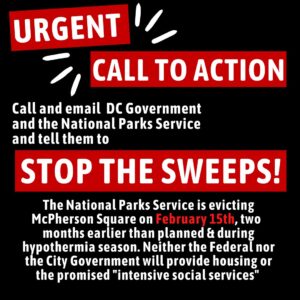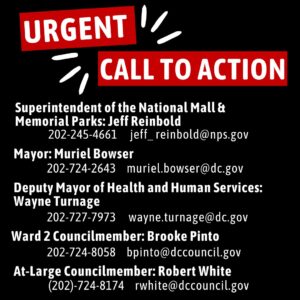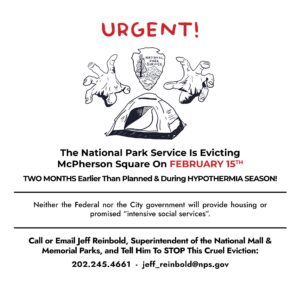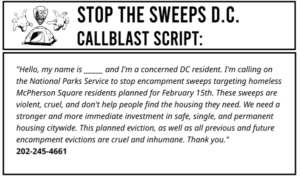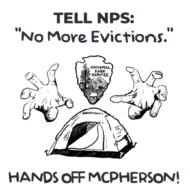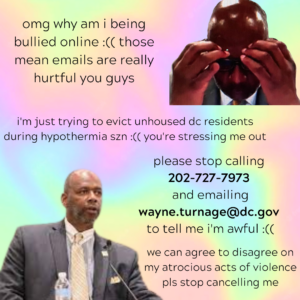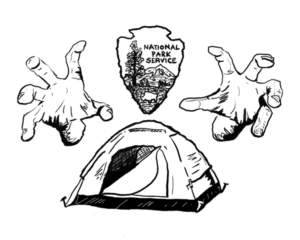PDF
What is an encampment?
– DC defines an encampment as “a set up of an abode or place of residence of one or more person on public property or an accumulation of personal belongings that is present even when the individual may not be”
Why are encampments important?
– Shelters are often inaccessible to large swaths of the homeless population for a
wide variety of reasons including, but not limited to:
– They’re not equipped to handle people experiencing mental illness.
Oftentimes, despite the fact that people with mental or psychiatric illness
are far more likely to be victims of violent crimes rather than the
perpetrators, people experiencing such conditions are barred from
entering shelters due to the perception that they are dangerous.
Additionally, many times staff are simply not equipped to support people
experiencing more extreme mental states.
– Unhoused people experience more violence at them. Whether it’s at the
hands of staff (due to a power differential), housed people targeting
vulnerable people, or other unhoused people, shelters are often a site of
violence, especially for women, disabled people, LGBTQ+ people, etc.
– Encampments are often safer because people are more able to
develop community ties and a support network through them,
giving people safety in numbers.
– For instance, in McPherson, a number of unhoused
women have their tents set up near each other so they can
watch out for each other and check in.
– They’re not accessible to people with disabilities
– They have strict sobriety requirements
– No pets are allowed. If an unhoused person has an animal companion,
they may choose not to stay in a shelter in order not to abandon their pet.
– Many shelters are sex segregated, meaning many families and couples
would have to separate in order to be in them
– Many shelters have strict curfews that, aside from being demeaning and
restrictive, are often not accessible for many people who may have jobs
or other responsibilities.
– They are often paternalizing and/or demeaning environments, controlling
when residents go to bed, get up, eat, etc.
– They often have limited capacity and physically cannot shelter every
unsheltered person in the area
– They are intended for short-term shelter, not long-term. Most you can only
stay a night at a time, giving unhoused people very little stability.
Additionally, at most you can only stay during the night, forcing people to
find somewhere else to stay during the day.
– Many have inadequate storage or limit the amount of stuff people can
bring in with them
– Many shelters bar people with criminal backgrounds
– Many shelters bar LGBTQ+ people
– There is often no privacy in shelters
– Shelters are often crowded and poorly ventilated, making them breeding
grounds for communicable diseases (including COVID).
– Unhoused people experience illness, both communicable and noncommunicable, at a rate 3 to 6 times higher than housed
people
– While data regarding homelessness and COVID-19 is spotty and
likely underestimated, this study reports that unhoused people
have a greater risk of symptomatic infection and COVID mortality
than the housed population
– Encampments, in contrast, often provide some semblance of safety (as explained above), community, stability, and autonomy that is not available at shelters.
– Many homeless advocates cite them as an important stage in working towards
the end goal of getting people housed
– It’s also important to note that according to research conducted by qualitative
sociologist, Charles Lanfear, on average, there is no association between
increased encampments/encampment size and crime
Experiencing homelessness is incredibly difficult and dangerous:
– A study from 2020 estimated deaths among the homeless population in 13 cities and 1 state found that across most of the examined communities, deaths among unhoused people have increased substantially over the past 5 to 10 years
– For instance, in New York City, from 2008 to 2018, deaths among the unhoused
population increased by over 50%. In LA, deaths among homeless people have
doubled from 2014 to 2019
– It’s also important to note that this study makes a point of stating that the
numbers they are reporting are an underestimate because most data regarding
homelessness in the US vastly under reports it.
– For every age group, unhoused people are three times more likely to die than the general population
– The average age of death for an unhoused person is 50 whereas the average
age of death for the general population, as of 2021, was 76.
– Unhoused people experience illness, both communicable and noncommunicable, at a rate 3 to 6 times higher than housed people
– Many shelter conditions, which are often overcrowded and poorly ventilated,
promote the spread of communicable disease
– Physical health conditions like heart disease are also a major cause of unhoused
deaths. This is in large part attributed to “the difficulty getting rest, maintaining
medications, eating well, staying clean and staying warm prolong and exacerbate
illnesses, sometimes to the point where they are life threatening (1)”
– In the coldest areas, unhoused people with a history of cold-related health conditions are eight times more likely to die from exposure than housed people with similar medical histories.
Clearing encampments makes life for unhoused people much harder:
– In a study conducted in Honolulu, Hawaii found that many personal belongings were destroyed or confiscated as part of sweeps:
– 57% lost their personal identification
– Losing one’s identification while homeless makes accessing services
much harder. Further, the conditions of homelessness make it so much
harder to replace
– 43% lost clothing
– 40% lost their tents
– 21% lost medicine
– 81% said they were unable to retrieve confiscated items from authorities
– Sweeps are also often violent, degrading, destabilizing
– Sweeps often force unhoused people into more and more remote areas where it’s harder for them to access services and support. Further, the instability that sweeps breed makes it harder for service providers to get in touch with and support their clients.
Clearing Encampments is a waste of resources:
– Over the course of ten months, the city of San Francisco swept 272 encampments which cost them an approximate $186,000. Many of these encampments simply moved or reopened.
– In Honolulu, the city spends approximately $750,000 a year sweeping encampments that continue to move or reopen
More info about the PIT Count
Sources:
No Rest for the Weary: Why Cities Should Embrace Homeless Encampments
National Homeless Mortality Overview
Homeless camps are often blamed for crime but experts say it’s not so simple
The Cold Hard Facts about the Deaths of Homeless People
The Truth About Why Homeless People Avoid Shelters
Additional Sources:
Vancouver’s Oppenheimer Park homeless camp brings community, safety, says resident
Don’t Count On It: How the HUD Point-in-Time Count Underestimates the Homelessness Crisis in America
The High Cost of Clearing Tent Cities
6 reasons why displacing the homeless must stop, regardless of COVID-19
Homeless tent cities play life-saving role and should be embraced, not battled, expert says
An Overview of Homeless Encampments for City Leaders
The Pitfalls of HUD’s Point-in-Time Count
